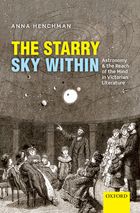Tracing unexplored connections between nineteenth-century astronomy and literature, The Starry Sky Within offers a new understanding of literary point of view as essentially multiple, mobile, and comparative. Nineteenth-century astronomy revealed a cosmos of celestial systems in constant motion. Stars, comets, planets, and moons coursed through space in complex and changing relation. As the skies were in motion, so too was the human subject. Astronomers showed that human beings never perceive the world from a stable position. The mobility of our bodies in space and the very structure of stereoscopic vision mean that point of view is neither singular nor stable. We always see the world as an amalgam of fractured perspectives.
In this innovative study, Henchman shows that the reconceptualization of the skies gave poets and novelists new spaces in which to indulge their longing to escape the limitations of individual perspective. She links astronomy and optics to the form of the multiplot novel, with its many centers of consciousness, complex systems of relation, and crisscrossing points of view. Accounts of a world and a subject both in relative motion shaped the form of grand-scale narratives such as Tess of the D'Urbervilles, Bleak House, and Daniel Deronda. De Quincey, Tennyson, and Eliot befriended leading astronomers and visited observatories, while Hardy learned about astronomy from the vast popular literature of the day. These writers use cosmic distances to dislodge their readers from the earth, setting human perception against views from high above and then telescoping back to earth again. What results is a new perception of the mobility of point of view in both literature and science.
"A highly original academic study, which offers a genuinely fresh way of thinking about some classic Victorian literature. Anna Henchman argues that, far more than was previously supposed, the Victorian imagination was fascinated by contemporary astronomy, and morally transformed by the stellar visions of a mysterious, ever-expanding and possibly godless universe. She carefully introduces a series of astronomical concepts such as parallax, optical distortion, and gravitational attraction, then skilfully applies these as critical metaphors to a well-chosen collection of Victorian authors, thereby bringing them into surprising new focus. In the process, she wonderfully succeeds in creating what is virtually a new critical discourse." - Richard Holmes, author of The Age of Wonder
"Out of this world! Written with elegance and erudition, Henchman's The Starry Sky Within extends the reach of literature to the cosmos, where it reflects new truths and fresh insights." - Karen Chase, Linden Kent Memorial Professor, University of Virginia
"This impressively wide-ranging study focuses our attention on the extremes and contrasts that Romantic and Victorian people realized as they contemplated human and astronomical life. Henchman makes compelling connections between narrative and astronomical spaces across a range of writers." - Dame Gillian Beer, King Edward VII Professor of English Literature, and President of Clare Hall, Cambridge University
Available through University of Oxford Press
